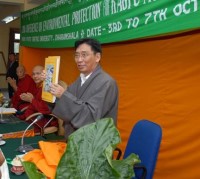法王新闻 | 2009年10月
召開第二屆噶舉傳承環保會議【第一天日誌】
地點:印度 上密院
時間:2009年10月03日
報導:Tashi Paljor
攝影:Tashi Paljor
法王於印度達蘭沙拉上密院召開第二屆噶舉傳承寺院、中心環保會議,來自傳承寺院中心的代表們齊聚出席於10月3日起一連五天的環保會議。
第一天:2009年10月3日(星期六)
Day One: Saturday 3rd October, 2009
第一屆環境保護會議於2009年3月召開,有來自印度、尼泊爾和不丹等地22所噶寺院代表出席會議。而第二屆會議,出席的噶舉寺院已增加到33所。參加會議的寺院代表們一早即陸續抵達會議大廳。於法王座位上方懸掛著一幅大型的綠色布條上頭標示第二屆噶舉傳承寺院、中心環保會議的字樣。
上午會議:歡迎儀式
The Morning Session Welcome Ceremony
歡迎儀式於上午八時三十分正式展開,由維那師 Woser Rabten帶領與會大眾一起唱誦祈願文後,接著是獻上傳統藏族酥油茶和糯米飯給所有的嘉賓。
The Welcome Ceremony began promptly at 8.30am with the chanting of prayers, led by Umze Woser Rabten, followed by an offering of traditional Tibetan butter tea and sweet rice to all the guests.

開幕式上由衛生部長致詞
Opening speech by the Minister of Health
西藏流亡政府衛生部長噶倫帕爾喬次仁應邀發表開幕詞。他強調二十一世紀中,由於物質的過度發展,已經把我們帶向了一個危險的處境,造成了前所未有的污染,使環境受到了很大的破壞,他指出,酸雨現象造成了花草樹木的損害及飲水和空氣的污染。對空氣污染的嚴重,他舉例說,某一個國家,那裡的人們可能要買一個半小時的氧氣供應,以獲得一些紓緩。他說,現在由於法王噶瑪巴已經在噶舉傳承中提出了對環保議題的認識及倡導環保運動,而此影響不僅會穩定增長,亦將在世界各地造成廣汎的迴嚮。
The Honourable Kalon Paljor Tsering, Minister of Health in the Tibetan Government-in-Exile, gave a short opening speech. He emphasised how material progress has led to a dangerous situation in the twenty-first century because of unprecedented pollution which is causing extensive damage to the environment – he cited acid rain which damages plants and trees, poisoned drinking water and polluted air. He gave one example from a certain country where people were able to buy half-an-hour’s supply of oxygen in order to get some relief. He expressed the hope that now that His Holiness the Gyalwang Karmapa had raised awareness of environmental issues amongst the Kagyu, and initiated an environmental protection movement, the influence of his work would grow steadily and spread throughout the world.
藏文版的環保準則正式推出
Launch of the Tibetan edition of Environmental Guidelines
在一個簡短的儀式上,衛生部長噶倫盛重打開了一個布函,裡面包裹著是大家期盼已久的藏文版《噶瑪噶舉佛教寺院,中心和團體的環保準則》,此書是由法王噶瑪巴根據英文版親自翻譯而成。
In a short ceremony, the Kalon opened a pe-ray containing copies of the eagerly-awaited Tibetan edition of the Gyalwang Karmapa’s booklet on environmental issues Guidelines for Karma Kagyu Buddhist Monasteries, Centers and Community, translated into Tibetan from the original English by the Gyalwang Karmapa himself.
此書隨即被分發給與會人士,每人手中一本,在拿到書後,與會代表們個個立即翻閱掃讀。
Representatives receive copies of the booklet. The booklets were distributed and immediately everyone began reading and flicking through the pages!
法王的簡介
His Holiness the Gyalwang Karmapa’s Introduction to the Conference

在法王噶瑪巴回顧此書的歷史部份後,親自對在場的每位人士朗讀了書中的序言。他警告說,環境變化情況也許不是馬上就可看的到,但卻是累積的。法王舉出了青蛙的例子,將一隻放入盛滿冷水的容器中燒煮,如同那隻青蛙是不會馬上就注意到自身所處的危險,而當它最後發現是身處熱水中時,卻為時已晚了。
His Holiness the Gyalwang Karmapa then gave the introductory address. After reviewing the history of the booklet, he read the introduction to everybody. He warned that environmental changes happen very slowly but are cumulative and gave the example of a frog in a water container. If you catch a frog and put it into a container of water and light a fire under it , the frog won’t notice the water is getting hot and when it finally does, its too late.
法王也説到,靠個己的微薄力量是不能保護環境的,我們必須要有一個團隊來共同努力,而這也就是我們齊聚於此開會以學習如何保護環境的原因了。環境保護往往被視為是需要提出來討論的議題或是如同政治問題一般,但法王噶瑪巴卻是將環保視為是實修佛法的重要部份,是實修佛陀教言廣利眾生的修行。
Á few individuals on their own cannot protect the environment; we have to work together as a team to do it and that is the reason why the conference has gathered here to learn about how to protect the environment. Often environmental issues are seen as something to be discussed or as political issues, but Gyalwang Karmapa saw them as an essential part of dharma practice, working for the benefit of all sentient beings, as contained in the words of the Buddha, .
長久以來,人們盲目的行為而忽視了對環境所造成的損害,如果這種情況仍持續存在,那麼我們將可能走到無力挽回的危險處境。法王噶瑪巴也提到了噶舉巴和環境保護之間的特殊關係,並承諾要在稍後的會議中詳述這個主題。
For too long, people have behaved thoughtlessly and ignored the damage to the environment that they are creating and, if this continued there was a great danger that it would be too late to do anything. Gyalwang Karmapa posited a special connection between the environment and the Kagyupa, and promised to expand on this theme later in the conference.
寺院提出環保工作的進度報告
Environmental Protection at Work in the Monasteries and Nunneries
最後,輪到各寺院提出報告和意見,依地區逐一報告,以今年(2009)三月份召開的第一屆環保會議中所擬定的環保108準則,在其實際運作上的進度上提出報告。其中許多寺院已種植樹木和植物等。在尼泊爾的一些寺院中也設有資源回收的系統如塑膠類製品的回收。在過去,許多人使用蔬菜殘餘來餵食豬牛等,但由於蔬菜殘餘不能用如此的方式處理,現在也改用堆肥的技術,將蔬菜殘餘轉成肥料而使用在花園和田地的種植上。
Finally, it was the turn of the monasteries and nunneries to present feedback, region by region, on the action that they had taken to implement the environmental guidelines and the 108 methods, since the March conference.
Many of them had planted trees and plants. In Nepal, the monasteries and nunneries had organised a recycling system for plastics, and, though they had already been using vegetable waste to feed the cows and pigs, waste that couldn’t be used that way, was now being composted and used in the gardens and fields.

下午會議
The Afternoon Session
下午的會議是由擔任會議協調人的Dekil Chungyalpa小姐主持,Dekil小姐目前是在總部設於美國華盛頓特區的世界野生動物基金會工作。她略述了五項環境問題,此亦為環保準則小冊子內的五大環保項目,她同時也提供了最新科學發現有關地球環境的訊息。
The afternoon session was led by Ms Dekil Chungyalpa, the conference facilitator, who works for the World Wildlife Fund, U.S.A., based in Washington, D.C… She gave an overview of the five environmental issues which form the core of the Environmental Guidelines booklet and provided information on the latest scientific findings.
His Holiness Karmapa has returned to Gyuto, after successfully completing the Delhi leg of his tour. His Holiness has reached Dharamsala via road from Delhi and will resume his daily activities in Gyuto.
